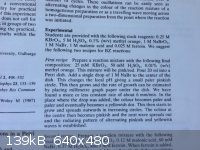
ScienceHideout - 11-7-2013 at 18:06
Hey everyone!
Maker Faire coming up- I will have a booth doing chemistry experiments! One reaction I think will be neat is the BZ reaction. The one where red and
blue ripples go across a petri dish and 'magically' disappear upon collision? The only prob is I lack ferroin... But then I was thinking- what is the
ferroin really doing? It is just being a redox indicator- nothing different from methylene blue or indigo carmine!
Ferroin goes from blue to red @ +1.06 V.
Methylene blue (at pH 7) is reduced to the blue form at +.01 V.
Indigo Carmine (@ pH 7) goes blue at -.13 V.
Because I don't have ferroin- I am looking to substitute another (almost as spectacular) indicator. Would either indigo carmine or methylene blue
work? Which would you choose? Would they be too sensitive?
Thanks a lot in advance- electrochemistry and redox is not my area 
-SciHide
Mailinmypocket - 12-7-2013 at 03:56
I'm pretty sure I have a BZ demo paper somewhere that lists methyl orange as an indicator... Ill try and find it and edit the post later on, but I
think you can use methyl orange...
-edit- okay so I managed to find the paper but lacking a scanner I had to take a picture of the experimental, hopefully it is of use.
"Creating BZ reactions in a Petri dish" Biochemical Education, 23(4) 1995

[Edited on 12-7-2013 by Mailinmypocket]
ScienceHideout - 12-7-2013 at 11:43
Okay- this will surely work! Thanks a lot!
EDIT: This is similar to, but not, the BZ reaction, though, correct? I actually like this version better, because that it doesn't use expensive
malonic acid. But for this KBrO3/NaBr version I can technically use methyl orange or universal. Correct?
[Edited on 12-7-2013 by ScienceHideout]
Mailinmypocket - 12-7-2013 at 15:00
By definition this is a BZ reaction- I've not yet tried this version of the BZ reaction to be honest, I just remembered having a demo of it using
methyl orange. I know that malonic acid can be replaced with citric acid but if I remember correctly it creates a more cloudy reaction, maybe somebody
with experience using citric acid could elaborate more on that. Based on my experience and memory, using malonic acid and ferroin (made using 1-10
phenanthroline and ferrous sulfate) the "waves" expanded more rapidly than the 6mm/min as written in the attached experimental though. If you did want
some malonic acid it can be had relatively cheaply from an eBay seller called chemdreamland-eu for ~$9/50g, I have purchase many times from this
seller, A+. I would be interested in seeing the methyl orange method sans malonic acid though, perhaps I will try it myself and see.

